CHEMICAL IDENTIFICATION
-
RTECS NUMBER :
-
KH5425000
-
CHEMICAL NAME :
-
Ethane, 1,2-bis(2-chloroethylthio)-
-
CAS REGISTRY NUMBER :
-
3563-36-8
-
BEILSTEIN REFERENCE NO. :
-
1739199
-
LAST UPDATED :
-
199612
-
DATA ITEMS CITED :
-
9
-
MOLECULAR FORMULA :
-
C6-H12-Cl2-S2
-
MOLECULAR WEIGHT :
-
219.20
-
WISWESSER LINE NOTATION :
-
G2S2S2G
HEALTH HAZARD DATA
ACUTE TOXICITY DATA
-
TYPE OF TEST :
-
LCLo - Lowest published lethal concentration
-
ROUTE OF EXPOSURE :
-
Inhalation
-
SPECIES OBSERVED :
-
Human
-
DOSE/DURATION :
-
300 mg/m3
-
TOXIC EFFECTS :
-
Lungs, Thorax, or Respiration - fibrosis, focal (pneumoconiosis) Lungs, Thorax, or Respiration - cyanosis Lungs, Thorax, or Respiration - other changes
-
REFERENCE :
-
SCJUAD Science Journal. (London, UK) V.1-7, 1965-71. For publisher information, see NWSCAL. Volume(issue)/page/year: 3(4),33,1967
-
TYPE OF TEST :
-
LC50 - Lethal concentration, 50 percent kill
-
ROUTE OF EXPOSURE :
-
Inhalation
-
SPECIES OBSERVED :
-
Rodent - rat
-
DOSE/DURATION :
-
11 mg/m3/10M
-
TOXIC EFFECTS :
-
Behavioral - ataxia Lungs, Thorax, or Respiration - dyspnea Gastrointestinal - hypermotility, diarrhea
-
REFERENCE :
-
TXAPA9 Toxicology and Applied Pharmacology. (Academic Press, Inc., 1 E. First St., Duluth, MN 55802) V.1- 1959- Volume(issue)/page/year: 5,677,1963
-
TYPE OF TEST :
-
LC50 - Lethal concentration, 50 percent kill
-
ROUTE OF EXPOSURE :
-
Inhalation
-
SPECIES OBSERVED :
-
Rodent - mouse
-
DOSE/DURATION :
-
6 mg/m3/10M
-
TOXIC EFFECTS :
-
Behavioral - ataxia Lungs, Thorax, or Respiration - dyspnea Gastrointestinal - hypermotility, diarrhea
-
REFERENCE :
-
TXAPA9 Toxicology and Applied Pharmacology. (Academic Press, Inc., 1 E. First St., Duluth, MN 55802) V.1- 1959- Volume(issue)/page/year: 5,677,1963
-
TYPE OF TEST :
-
LDLo - Lowest published lethal dose
-
ROUTE OF EXPOSURE :
-
Subcutaneous
-
SPECIES OBSERVED :
-
Rodent - mouse
-
DOSE/DURATION :
-
10 mg/kg
-
TOXIC EFFECTS :
-
Details of toxic effects not reported other than lethal dose value
-
REFERENCE :
-
NTIS** National Technical Information Service. (Springfield, VA 22161) Formerly U.S. Clearinghouse for Scientific & Technical Information. Volume(issue)/page/year: PB158-507
-
TYPE OF TEST :
-
LC50 - Lethal concentration, 50 percent kill
-
ROUTE OF EXPOSURE :
-
Inhalation
-
SPECIES OBSERVED :
-
Mammal - dog
-
DOSE/DURATION :
-
90 mg/m3/2M
-
TOXIC EFFECTS :
-
Behavioral - ataxia Lungs, Thorax, or Respiration - dyspnea Gastrointestinal - hypermotility, diarrhea
-
REFERENCE :
-
TXAPA9 Toxicology and Applied Pharmacology. (Academic Press, Inc., 1 E. First St., Duluth, MN 55802) V.1- 1959- Volume(issue)/page/year: 5,677,1963
-
TYPE OF TEST :
-
LC50 - Lethal concentration, 50 percent kill
-
ROUTE OF EXPOSURE :
-
Inhalation
-
SPECIES OBSERVED :
-
Rodent - guinea pig
-
DOSE/DURATION :
-
8 mg/m3/10M
-
TOXIC EFFECTS :
-
Behavioral - ataxia Lungs, Thorax, or Respiration - dyspnea Gastrointestinal - hypermotility, diarrhea
-
REFERENCE :
-
TXAPA9 Toxicology and Applied Pharmacology. (Academic Press, Inc., 1 E. First St., Duluth, MN 55802) V.1- 1959- Volume(issue)/page/year: 5,677,1963
-
TYPE OF TEST :
-
LDLo - Lowest published lethal dose
-
ROUTE OF EXPOSURE :
-
Subcutaneous
-
SPECIES OBSERVED :
-
Rodent - guinea pig
-
DOSE/DURATION :
-
40 mg/kg
-
TOXIC EFFECTS :
-
Details of toxic effects not reported other than lethal dose value
-
REFERENCE :
-
NTIS** National Technical Information Service. (Springfield, VA 22161) Formerly U.S. Clearinghouse for Scientific & Technical Information. Volume(issue)/page/year: PB158-507
-
TYPE OF TEST :
-
LC50 - Lethal concentration, 50 percent kill
-
ROUTE OF EXPOSURE :
-
Inhalation
-
SPECIES OBSERVED :
-
Rodent - hamster
-
DOSE/DURATION :
-
22 mg/m3/10M
-
TOXIC EFFECTS :
-
Behavioral - ataxia Lungs, Thorax, or Respiration - dyspnea Gastrointestinal - hypermotility, diarrhea
-
REFERENCE :
-
TXAPA9 Toxicology and Applied Pharmacology. (Academic Press, Inc., 1 E. First St., Duluth, MN 55802) V.1- 1959- Volume(issue)/page/year: 5,677,1963
-
TYPE OF TEST :
-
LC50 - Lethal concentration, 50 percent kill
-
ROUTE OF EXPOSURE :
-
Inhalation
-
SPECIES OBSERVED :
-
Bird - pigeon
-
DOSE/DURATION :
-
61 mg/m3/10M
-
TOXIC EFFECTS :
-
Behavioral - ataxia Lungs, Thorax, or Respiration - dyspnea Gastrointestinal - hypermotility, diarrhea
-
REFERENCE :
-
TXAPA9 Toxicology and Applied Pharmacology. (Academic Press, Inc., 1 E. First St., Duluth, MN 55802) V.1- 1959- Volume(issue)/page/year: 5,677,1963
|
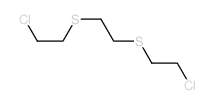
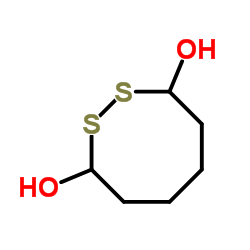 CAS#:5244-34-8
CAS#:5244-34-8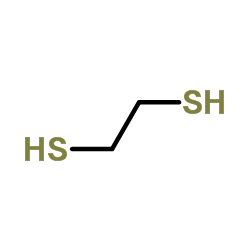 CAS#:540-63-6
CAS#:540-63-6 CAS#:107-04-0
CAS#:107-04-0 CAS#:505-60-2
CAS#:505-60-2 CAS#:111-48-8
CAS#:111-48-8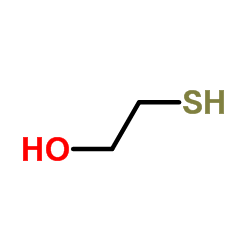 CAS#:60-24-2
CAS#:60-24-2 CAS#:75-01-4
CAS#:75-01-4 CAS#:7647-01-0
CAS#:7647-01-0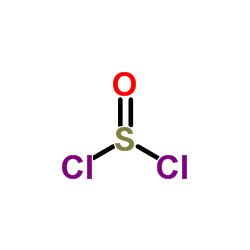 CAS#:7719-09-7
CAS#:7719-09-7 CAS#:505-29-3
CAS#:505-29-3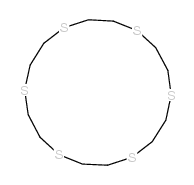 CAS#:296-41-3
CAS#:296-41-3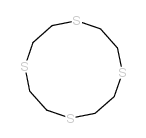 CAS#:25423-56-7
CAS#:25423-56-7![2-[2-(2-sulfanylethylsulfanyl)ethylsulfanyl]ethanethiol structure](https://image.chemsrc.com/caspic/060/25423-55-6.png) CAS#:25423-55-6
CAS#:25423-55-6![2-[2-[2-[2-(2-hydroxyethylsulfanyl)ethylsulfanyl]ethylsulfanyl]ethylsulfanyl]ethanol structure](https://image.chemsrc.com/caspic/435/99868-22-1.png) CAS#:99868-22-1
CAS#:99868-22-1 CAS#:1784-73-2
CAS#:1784-73-2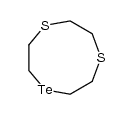 CAS#:341547-75-9
CAS#:341547-75-9![N-butyl-N-[2-[2-[2-(dibutylamino)ethylsulfanyl]ethylsulfanyl]ethyl]butan-1-amine structure](https://image.chemsrc.com/caspic/291/7512-33-6.png) CAS#:7512-33-6
CAS#:7512-33-6![2-[2-[2-(diethylamino)ethylsulfanyl]ethylsulfanyl]-N,N-diethylethanamine structure](https://image.chemsrc.com/caspic/129/97173-37-0.png) CAS#:97173-37-0
CAS#:97173-37-0